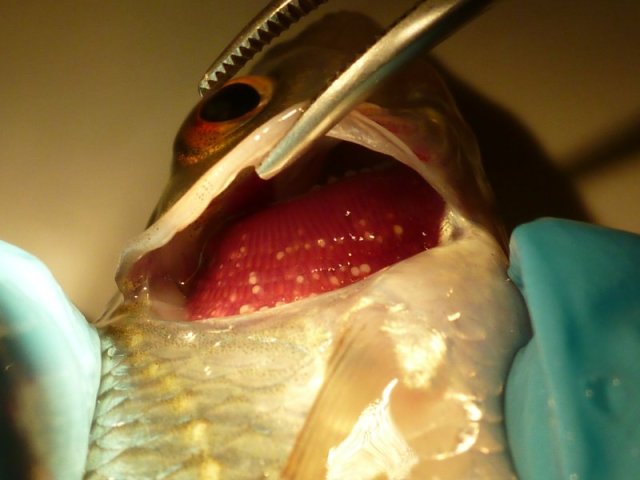If you’ve read any of my posts, you should realize by now that clams are pretty weird. Some catch live prey. Some have algae in their bodies that they “farm” for food. Some can bore into hard rock. Some sail the seas on rafts of kelp. Clams live in a competitive world and have had hundreds of millions of years of time to evolve to try out all sorts of weird, unlikely ways of life.

The thick shelled river mussel (Unio crassus) is known from many rivers and streams of Central Europe. As this is a very well-studied region of the world, many generations of academics have noted an unusual, seemingly inexplicable behavior undertaken by these mussels at certain times of year.

Using its muscular foot, U. crassus pulls itself to the edges of the streams and rivers it lives in until it is partially exposed to air. It orients itself at a right angle with the surface of the stream with its siphons (two little snorkels coming out of the shell) facing out towards the water. Like all bivalves, U. crassus can act as a bellows by opening and closing its shell to pull in and push out water through those siphons. It has one siphon above the water and one below, and it proceeds to suck in water and spray it into the center of the stream using the power of its suction. The water can travel over a meter away and they continue this spurting about once a minute, sometimes for hours.

Needless to say, this is a very strange and unlikely behavior to observe in a mussel. It is exposing itself to potential dessication or suffocation from exposure to air. It is vulnerable to predation from terrestrial mammals and birds. There has to be a very powerful benefit from this behavior to outweigh those risks. And why squirt water into the air?
Some researchers proposed that the mussels were traveling to shore to harvest from the more plentiful food particles deposited there. But why would they face their siphons away from the shore then? Other workers suggested that it was a way to reduce heat stress through evaporation, though that also seems unlikely, considering the water is warmest in the shallows. The question persisted for decades in the minds of curious malacologists.

In 2005, Heinrich Vicentini of the Swiss Bureau for Inland Fisheries and Freshwater Ecology decided to try settle the question of why these mussels spurt. He observed several dozen of the mussels crawl to the edge of the water and diligently begin squirting into the streams. In the name of science, he put himself in the path of these squirts, caught the water and used a hand lens to observe that the squirted water was full of mussel larvae (glochidia).

U. crassus falls in the order Unionida, a group of freshwater mussels distinguished by a very unusual method of reproduction. They are parasites! Because they can’t swim well enough to colonize upstream against the current, they need to rely on fish to hitch a ride. Some have evolved elaborate lures to convince fish to take a bite, then allowing them to release their larvae, which attach to the fish’s gills like binder clips and ride all the way upstream. Once they have reached their destination, they detach and grow up into more conventional burrowing mussels. It’s a weird, creepy and wonderfully brilliant strategy that enabled the mussels to invade the inland rivers which would otherwise be inaccessible to them.

The mussels appear to be spurting out not only water, but their babies. They gain a couple of advantages from this. For one, their larvae can distribute further than would be possible from the bottom of the creek. Instead, they are released at the center of the surface of the stream, where they can be carried for a much longer distance by the current before they settle at the bottom. In addition, the splash of water on the surface may mimic the behavior of insects and other fish food falling in the water. A curious minnow might venture to investigate the source of the splash, where it would promptly breathe in a cloud of larvae that get stuck on its gills. A pretty rude surprise, but a brilliant trick to give the baby mussels the best chance of surviving.
So again, clams prove themselves to be far more clever and interesting than they might initially seem. U. crassus and other members of the Unionida are an ancient and globally distributed lineage which have evolved all sorts of weird and wonderful ways to maintain their river lifestyle. Unfortunately, rivers are some of the most widely damaged environments in the world. A majority of freshwater mussel species worldwide including U. crassus are endangered by habitat loss, overharvesting and pollution. But more research into their unusual biology can help us understand ways we can enhance their conservation, with the hope of providing more habitat for them to recover populations in the future. New projects in Sweden and other countries aim to recover habitat for their larvae to settle along 300 km of rivers, and research the fish species which their larvae prefer to hitch a ride on. With more work, we can hopefully ensure that the streams of Europe will harbor little mini super-soakers for millennia to come.
